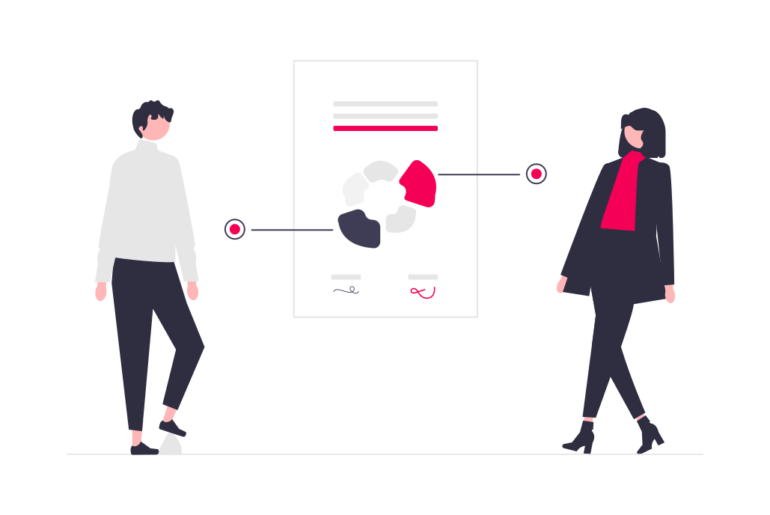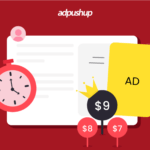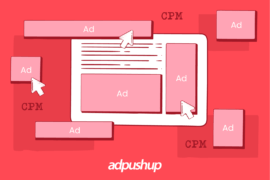In the digital advertising world, RPM and CPM are two metrics to monitor ad revenue. Let’s understand the difference between RPM and CPM.
Let me guess, you were looking through your AdSense account, checking your earnings and noticed a difference in your RPM and CPM rates. The numbers didn’t match. And now you are confused about which one to go after to understand your earnings.
Well, you are not alone. RPM and CPM are two metrics that often confuse publishers.
So, let’s start with the basics and then understand the difference between them.
What is CPM?
CPM stands for Cost Per Mille or Cost Per Thousand Impressions. It’s a popular term used by digital advertisers and marketers. It’s an advertiser-side metric used to track the campaign expense. Every time a CPM model-based ad serves an impression on a publisher’s web page, the publisher earns from it.
This model is different from CPC (cost-per-click) ads, where users need to click on an ad for a publisher to make money.
The formula to calculate CPM:
CPM = (Cost of the campaign / Number of impressions) * 1000
Here is an example to simplify it:
Suppose an advertiser sets a budget of $4000 for a CPM-based campaign. He invests in an inventory with a total of 4,000,000 (4 million) impressions. What will be the advertiser’s CPM?
(4000 / 4,000,000) * 1000 = $1 CPM. This is the amount the advertiser will pay you (the publisher) for each impression.
How Important is CPM for Publishers?
CPM rates play a vital role for publishers in determining the pricing for their ad space and optimizing their ad revenue. Moreover, tracking CPM can bring the following benefits:
Boosts Revenue
Tracking CPM helps publishers set the right price for their ad inventory. While tracking helps with pricing, it also ensures that the publishers earn the best possible revenue from each ad impression.
Pinpoints Better Paying Advertisers
The curated CPM data helps in identifying the advertisers who will be willing to pay a good price for ad space.
Helps in Optimizing Ad Formats
CPM can be used to recognize the best-performing ad formats so that publishers can make informed decisions on prioritizing the best-performing ad placements and their optimization.
Enhances Decision-Making
Tracking CPM also provides the benefit of making better data-driven decisions. Publishers can use the CPM data to analyze their ad strategy, pricing, and total ad revenue maximization.
What is RPM?
RPM or Revenue per Mille or Revenue per Thousand Pageviews is the estimated earnings of publishers based on the number of page views received. Here, RPM is the publisher-side metric that gives them a general idea about their earnings. However, the actual earnings after the ad are served can be more or less than the estimated RPM.
The formula to calculate RPM:
RPM = (Estimated earning / Number of pageviews) * 1000
Here’s another example to simplify it:
Suppose a publisher estimates his revenue, based on past records, to be around $600 for 600,000 pageviews. In that case, the RPM would be:
(600 / 600,000) * 1000 = $1 RPM. This is the estimated amount the publisher should expect to get.
How Important is RPM for Publishers?
RPM plays a key role when it comes to getting an estimation of ad revenue and better decision-making for boosting it. Apart from that, publishers get these benefits from RPM:
Helps in Monitoring Revenue
RPM helps publishers determine which ads are performing well and which placements are successful. This even works well when they need to monitor revenue and work on their ad placement strategies.
Makes Comparison Easier
Publishers often need to compare their inventory’s ad performance to decipher the errors and factors behind poor results. RPM surely helps in comparisons across different platforms and ad networks.
Helps With Value Analysis
With RPM, publishers can get a better understanding of their ad inventory’s value. As a result, they can place apt prices for advertisers and earn good profit.
Provides Valuable Insights
Tracking revenue growth is not enough when publishers have to gain performance insights into their ad campaigns. Analyzing RPM not only provides the perfect performance reviews of your ad campaigns but also helps you measure success and determine what improvements would be required.
What is the Confusion About RPM vs CPM?
CPM is an advertiser metric, while RPM is a publisher metric. Though Google AdSense uses RPM to tell publishers about their earnings shows CPM-based ads; this is the source of confusion.
Also, RPM is usually higher than CPM. This is because RPM measures the cost based on pageviews and the number of ad units on a web page. Whereas CPM retrieves the cost based on the number of impressions per ad unit.
For instance, a user visits a webpage with four ad units. Out of the four, one ad unit is placed below the content. Now, a user scrolls through the webpage to a point where only three ad units can serve impressions. In such a case, the CPM will be based on the number of ad units which received the impressions (which is three), whereas the RPM would be estimated by counting all four ad units. Similarly, if a publisher deals in 100,000 or more impressions a month, this difference increases.
This is the reason publishers often see a huge gap between CPM and RPM, pushing them to think something is wrong with their business practices. But at the same time, if you’re implementing the right practices to increase RPM, there is nothing for you to worry about.
Read More: Page RPM AdSense: Definition, Calculator, and Tips to Increase It
CPM vs RPM – Key Differences
Apart from the basic definition and importance of a website, the other key differences between CPM and RPM are mentioned in the given table:
| Factors | CPM | RPM |
| Target Metric | Advertiser-centric metric. | Publisher-centric metric. |
| Tracking | Tracks the cost of an ad campaign. | Tracks the revenue earned from ads. |
| Ad Placement | Depends on the ad price on the basis of their placement. | Depends on the overall revenue generated by ads. |
| Bidding | Used in ad auctions. | Irrelevant in ad auctions. |
| Ad Units | Used to measure the cost per impression of different ads. | measures the revenue earned from all ads. |
| Page Views | Depends on the impressions across a website or app. | Depends on the account page views |
Now that we know th differences RPM and CPM shares with each other, let’s quickly understand how both metrics relate to ad fill rate.
How are RPM, CPM, And Fill Rate Related to Each Other?
The fill rate measures the percentage of ads displayed in a particular ad space with respect to the total number of times an advertisement can be shown.
When it comes to the relationship between RPM, CPM, and fill rate, it is complex and mutually reliant. Higher CPM and fill rate contribute to higher RPM, but it’s not that simple as various factors interfere in the process.
Moreover, a low fill rate can depict lost revenue opportunities but may not have any effect on CPM and RPM if the ads are targeted well. As a publisher, you’ll have to optimize all three factors to maintain a perfect balance between them which eventually gives a high revenue
How to Derive CPM from RPM?
There’s no denying that CPM and RPM are two different terms, but it may sound surprising that both of them can be derived from each other.
For example, if you have 10 ad units on your webpage, and you’ve calculated the estimated earnings to be $0.50 for 10 page views. So, it’s clear from the definition mentioned above that RPM would be:
0.50/10×1000 = $50
This shows those 10 ad units will generate a revenue of $50 for every 1000 views.
Coming to calculating CPM, it’s estimated earnings divided by Ad units. So, in this case, it would be:
0.50/10 = $0.05
Hence, CPM = (CTA/page views) X 1000 = 0.05/10 x 1000 = $5
Is CPM Better Than RPM?
It is not a heated debate, but whenever it comes to finding out what’s better between CPM and RPM, both have to play a vital role in ad revenue generation.
However, RPM provides you with exact numbers for revenue generation, and CPM provides a proper performance analysis of each ad unit. In addition, the latter also helps in analyzing the worth of each unit to make a wise decision in the future.
In conclusion, all you can notice is that RPM will always be higher than CPM, no matter what. In the next section, let’s find out the reason behind that.
Possible Reasons for RPM Being Higher Than CPM
As mentioned earlier, RPM is higher than CPM. The reason is that RPM targets the revenue earned from all ad units on a webpage, while CPM targets only a single ad unit.
For example, when you decide to calculate the CPM for two sections of your webpage, half of the ad units are at the top and half of them at the bottom. So, when CPM is calculated within a range considering each ad unit. On the other hand, RPM will be the sum of all the CPMs on the webpage.
All-in-all, publishers have to optimize both CPM and RPM to get the best return on investment from the ad units. They can improve ad placements, ad formats, target audience, and more.
What Factors Affect CPM and RPM?
The calculated CPM and RPM of a page are never steady, as it depends on a lot of factors. That said, let’s take a look at a few factors affecting the two metrics.
Ad Placement
Ad placement is one of the most vital factors affecting RPM and CPM. Where your ads are placed on the website contribute a lot to maximizing revenue. The ads placed higher tend to perform better, as they get more attention from advertisers than ads placed lower.
Ad Format
The format in which the ad is placed can also be a decisive factor in calculating RPM and CPM rates. For example, display ads have a better reach than video or native ads. So, a publisher must experiment with all ad formats to get the best from their ad placements.
Ad Quality
Reducing low-quality ads on your website is essential; otherwise it will negatively impact the metrics. On the contrary, audience-focused and high-quality ads have a positive impact and also affect RPM and CPM.
Geographic Location
An ad being user-relevant also depends on the location where it is visible. Also, viewers belonging to Tier 1 countries have a high impact on CPM and RPM, and advertisers also prefer to pay more.
Niche or Topic
If a website covers interesting or trending topics or niches, it’s more likely to receive better metric numbers than the one covering irrelevant and saturated niches. Moreover, advertisers are often focused on a topic/niche and choose websites accordingly.
Seasonality
It’s obvious that particular seasons, like the holiday season, have higher ad spend. Hence, it eventually increases RPM and CPM rates. So, when it comes to optimizing ad inventory, a publisher must take seasonality trends into account.
Traffic Volume
Higher traffic is directly proportional to higher revenue. Hence, to increase a website’s RPM and CPM, a publisher must focus on increasing traffic.
User Behavior
The total time a user spends on a website also impacts its performance. User’s actions also include bounce rates and ad click-through rates. So, it is essential to make your website more engaging and welcoming to receive a positive response on its revenue metrics.
Ad Block Usage
When users are using ad blockers, the websites they visit may not have higher rates. Hence, using anti-ad blockers is highly recommended for publishers.
Web Cookies
Web browser cookies stored on a device can also impact its CPM and RPM. These are small files that contain useful data used by advertisers to track visitors and later target ads.
Price Floors
Publishers must set high price floors to avoid bid shading on their ad inventory. Bid shading is a practice that advertisers use to get ads for the lowest price possible.
RPM vs CPM: Which Should You Use to Analyse Earnings?
It’s up to you. Google AdSense shows publishers’ earnings via RPM. However, most ad networks consider CPM to show the publishers their earnings. But to note, none of these metrics, viz. CPM or RPM is accurate. These numbers are based on estimates, and hence the actual earnings can be different.
Now, RPM is great for keeping track of your earnings. It provides you with a goal that you can achieve. But, publishers shouldn’t focus on only RPM. Working only on RPM can backfire一you add more number of ad units per page to increase the RPM. But this might disrupt the user experience and increase your bounce rate. Also, too many ads can damage your site’s viewability score. The next thing you will notice is a significant fall in your earnings.
Next, CPM. A good CPM correlates with good quality content and hence a good viewability score. Also, CPM depends on the advertiser’s budget and requirements. If a publisher’s inventory fits well as per the advertiser’s requirement, then the advertiser will likely spend more on such inventory. By working to increase the CPM, publishers will try to improve the earnings of each ad unit per page. This will encourage publishers to provide proper space for content and ads, finally serving the better-performing ads.
What Future Holds for RPM and CPM?
There’s no doubt that CPM and RPM are crucial metrics to analyze the revenue of a website. However, there’s a possibility of a change in their significance and calculation in the future.
Increase in Demand for Header Bidding
Header bidding makes advertisers compete more, but, at the same time, increases the CPMs only for the publishers that know the nitty-gritty of the process and use them well. Considering this, publishers may shift their focus to overall RPM instead of individual CPMs.
Prioritization to Holistic Metrics
With CPM still holding relevancy, publishers are most likely to consider comprehensive metrics beyond RPM. These metrics may include viewability, engagement, and customer value over a long period of time.
Impact of AI and Machine Learning
AI is already showing its efficiency in almost every line of business you can think about. Soon, it will show its impact on Ad optimization as publishers will start seeking help from AI to figure out relevant audience segments, appropriate ad placements, and predict fill rates.
Cancellation of Third-party Cookies
The publishers will somehow be relieved and stressed in the future when they get the option to get rid of third-party cookies and look for alternatives. So, instead of depending upon data stored in cookies, they’ll have to focus on using their own data and targeting based on content.
Cross-Channel Considerations
The advertising methods will be reshaped, instead of using only one channel, advertisers may draft a multichannel strategy. This means, publishers won’t have to consider ad CPM solely, as they’ll have to analyze the whole inventory and the whole marketing plan.
Conclusion
RPM is the metric for publishers to estimate their earnings. Whereas CPM tells about the amount, the advertiser is going to spend on the ad campaign. Also, publishers’ earnings are ever-fluctuating because it depends on multiple factors that make it difficult to measure accurately. The factors that the measurement is dependent on are:
- User behaviour is like whether the user is going to click an ad or not.
- How much time the user is going to spend on the web page?
- Whether or not the page is optimal to provide a good user experience and ad viewability.
Above all, irrespective of any metric used to calculate the ad revenue, RPM or CPM, the earnings will always be established by the number of impressions you get.
Frequently Asked Questions: RPM vs CPM
RPM measures the cost based on pageviews and the number of ad units. And CPM calculates the cost based on the number of impressions per ad unit. Both are important for ad publishers.
Suppose, for every 1000 page views, the 5 ad units will return a revenue of $8.75. Thus, CPM = (CTA/page views)* 1000 = ($0.05/40)*1000=$ 1.25.
For example, if there are 5 ad units on a page and $0.35 is the estimated earnings from 40 page views. So, the RPM will be 0.35/40*1000= $8.75.

Deepak has a keen eye for detail and a deep understanding of the ad tech landscape. Whether it’s through in-depth articles, thought-provoking insights, or compelling storytelling, he’s dedicated to helping people navigate the complex world of ad tech with the simplicity of his words.







